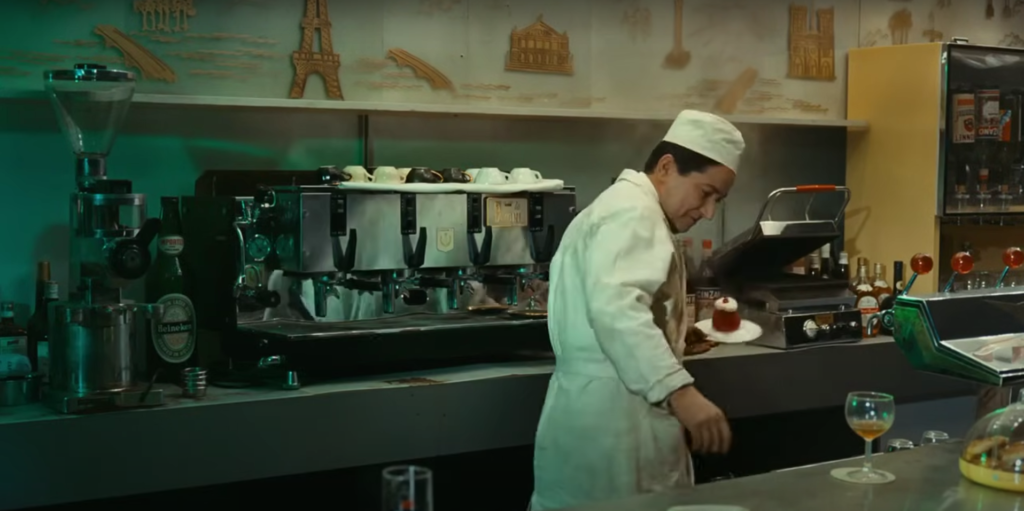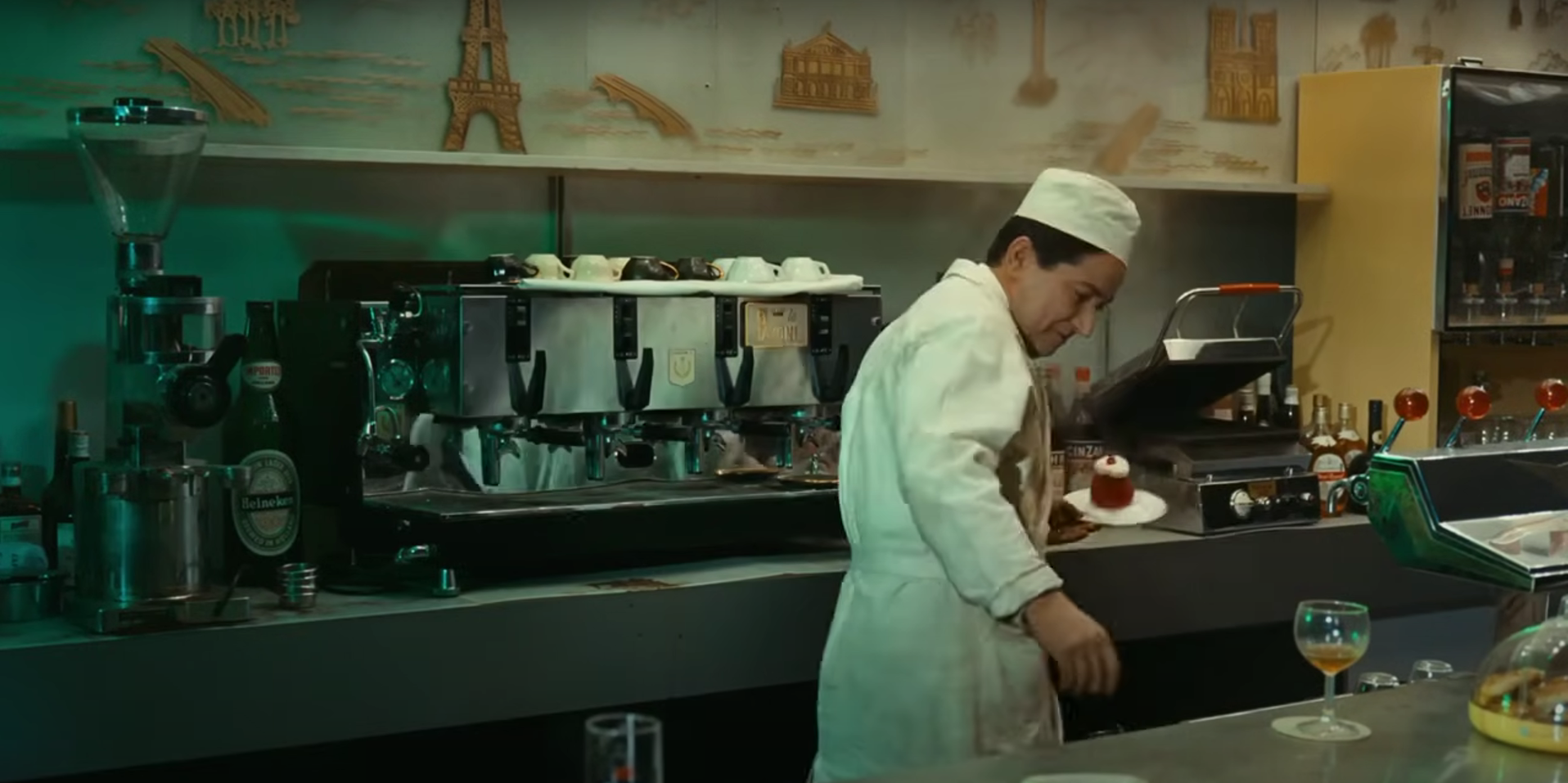By Neil Hogan
Jacques Tati’s movie Playtime features an advanced city of grey concrete and glass on the outskirts of Paris where residents and employees go busily, automatically or confusedly about their days. Across a day and a night, the film explores the lives of a variety of characters from a voyeuristic point of view but is essentially a collection of sight gags loosely joined together. The shot that this essay will explore features a café owner spraying white whipped cream on a red dessert, that then looks unappetising when he places it under green light. The shot is noticeable for its differing colours, the way it is lit, its props, the design of its set, the character’s actions and costume, and the multiple Italian symbols and motifs illuminated in its framing and composition. The effect of this is to help reinforce the comedy aspects of the film, and its placement allows viewers a rest before the final part. As such, it is a good example of creative mise-en-scene and cinematography.
The most noticeable thing about the lighting in the shot of the café owner and his dessert is the dramatic change in the use of colour at this point in Playtime. In most of the film, the colours of blue, white and red, symbolizing the flag of France, can be found amongst the greys and silver of the cityscape. When this shot appears it is quite striking that it features green, white and red. On the surface, the green is to give the sight gag of all the café owner’s desserts having changed to being unappetising under that colour light. The set is lit with a green fill light on the left, taking up a third of the screen. The key light is white from above, making the white clothes of the café owner, and the white of the cups on the coffee machine in the background stand out brightly. But there is also a deeper meaning. It is an Italian café, and green, white and red are the colours of the Italian flag, so these colours are present throughout the entire shot. While this is a comedy movie, and fill lighting is used extensively to remove shadows, this shot has shadows under the back shelf and around the green area, suggesting early morning. There may also be a diffuser to reflect more of the green on other parts of the set.

Playtime 1967 Directed by Jacques Tati
The props include a white plate with a red dessert on it and a whipped cream spray can. The café owner also briefly uses the café machine in the background. Nearby, another prop used is the trolley of desserts, the plates of which the café owner readjusts. At the end of the shot, another character is holding another prop, a plate of food. These all come together to make the shot of the changing dessert worthy of attention.
The café set is contemporary, and it is inside a building next to a drugstore which displays a bright green sign. An entire town had been built for the movie, so this shot was filmed on a set rather than at a location. The set features a lot of angles, with forty-five degrees being the most common. The upper back wall of the café displays raised Venetian plaster designs of iconic French monuments such as the Eiffel Tower and the Arc De Triomphe. These shapes mirror the handles, shadows and reflections below them. As it was the Italians of Venice that helped spread cafés throughout Europe, the motif of using Venetian plaster helps reinforce the Italian-ness of the set. The shape of the Eiffel Tower is emulated in tall bottles, cylindrical containers, tall glasses and other items, suggesting that this top image is there to lead the viewer to the other vertical and angular shapes nearby. The set also contains green, white and red items – not just relying on lighting alone. On the left is a green bottle with a green Heineken label, in the middle are white cups and other white objects, and on the right are several bottles with red caps and labels, not to mention red handles on the equipment on that side, further enhancing the Italian flag symbolism.
The depth of field is limited in that we have the counter, the café operator, and the coffee machine in the background. However, the glasses on the counter in the foreground and the café machine in the background are slightly out of focus, and when the camera pans to the desserts, the drug counter is blurred behind it. The differing focuses further enhance the depth of the shot.
In regard to action, the café owner’s body is quite expressive. His head is slightly tilted as he holds the dessert, aligning him perfectly with many of the angled shapes in the set. His bent right arm also mirrors the right angle side of a piece of equipment nearby, and the cut of his clothes also follow lines in the set. This helps to direct the viewer’s attention to the dessert, so that they notice he is spraying the whipped cream in a strange way. Normally, cream is sprayed from the top, and quickly covers food. The café owner, however, sprays either side of it, and when he turns to place it on the dessert trolley, the bright red of the food is framed by the white cream and is easily seen. It is clear to the viewer that when he goes to place it on the trolley, the red changes to a dark, unappetising colour. To further emphasize the gag, he takes it back from the green light and into the white light, before returning it again. He then quickly moves the dessert out of sight, symbolising the end of the gag, and redirecting attention to the trolley of other unappetising, greenly-lit desserts.
Another aspect that emphasises Italy is his costume. Rather than a pointed cap as is common in many cafés, this café owner is wearing a flat cap. This sets the café owner up to look like Italy’s Leaning Tower of Pisa. Flat top, leaning slightly to the viewer’s right, reflective of most Leaning Tower postcards. At the end of the shot, the café owner repeats his tilt to be in line with a leaning dessert, further emphasizing the Leaning Tower motif.
During the shot, the red dessert is the focal point. When the camera pans across to the left, the dessert and the café owner remain framed in the centre. It is a medium shot as the café owner is filmed above waist height. The shot is filmed at eye-level, horizontally and from the point of view of the viewer. It remains balanced throughout, even down to a secondary grinder on the left and the side of the cupboard on the right following the rule of thirds guides of a frame. When the character turns and places the dessert on the trolley, the trolley becomes the centre of the shot, framed by the café owner on one side and a new character eating food on the other. As the shot ends, the character of Monsieur Hulot moves into the frame, and the camera pans slightly to centre his back between the eater and the café owner, keeping the image balanced.
Diegetic sound is throughout this shot, most noticeably with a high pitched buzzing that is quickly identified as coming from a green cross sign. There is also the sound of hot water spurting from the coffee machine, the squelch of whipped cream, and plates being placed and repositioned. There is no underlying musical score so there are no non-diegetic sounds. The buzzing adds to the shot in that it creates an annoyance, as viewers would be reminded of a mosquito. The sound encourages the viewer to not only look for it, but also to reflect on the idea that one of the characters might be annoyed by it. By identifying with the sound, we quickly relate to the slightly annoyed café owner.
The placement of this shot comes at a time in the movie when a rest is needed – some light comedy (quite literally) before the film continues headlong into more chaotic shots. As food is usually eaten when a break is taken, this shot of coffee and desserts fits perfectly. With cinema still being influenced by plays at this time, Playtime offers this shot as a chance to reflect on what has happened so far and to prepare for the next section.
In summary, this shot has been filmed to convey Italy in multiple ways, such as the colours reflecting the Italian flag, the set featuring Venetian plaster, and a café owner looking like the Leaning Tower of Pisa. The effect this has is of continuing the comedy aspect of the film while allowing the viewer to have a break. With so much in such a short shot, it is a great example of creative mise-en-scene and cinematography.
Shot is approximately 1:18:00 to 1:18:20

